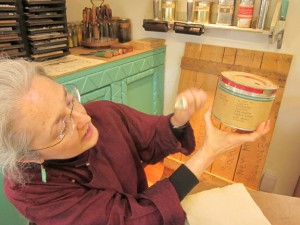Excerpt from http://www.nmhistorymuseum.org/blog/

Artist, printmaker and woodworker Gustave Baumann has a well-deserved “beloved” status in Santa Fe, his home for the final 53 years of his life. The Palace Press at the History Museum re-created his studio, using his original materials, tools and furnishings. The New Mexico Museum of Art owns a number of his prints (some of them on display in an exhibit right now) and the replicas and originals of marionettes he carved for theatrical performances.
So what’s a conservator from Indiana doing here this week prowling around his legacy? She’s trying to solve a couple of lingering mysteries that Baumann left behind.
“We’re going to do a museum exhibit of his prints, drawings and paintings in 2014,” said Claire Hoevel, senior conservator of paper for the Indianapolis Museum of Art, which holds a complete set of prints Baumann made during his youthful stint in that state’s Brown County Art Colony.
“Attached to that exhibit is a huge analytical project to find out exactly what his materials were — pigments, bindings, gessos, the fibers in his papers. Our hope is to gain a very thorough understanding of Baumann and his processes, how he worked, and his enormous accomplishments.”
Thanks to the bottles, cans and jars of materials Baumann left after his 1971 death — materials that are now part of the Palace Press’ exhibit — Hoevel has an opportunity rare in conservator circles. …


